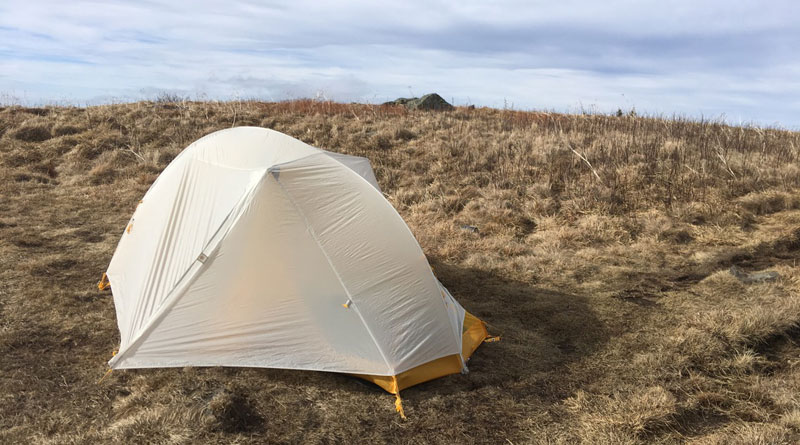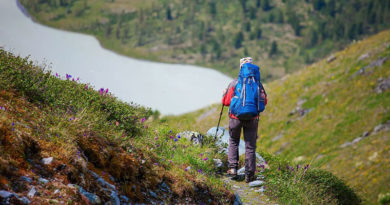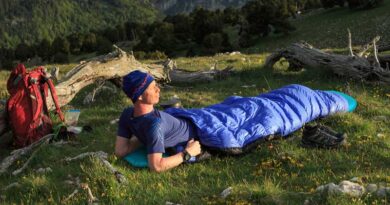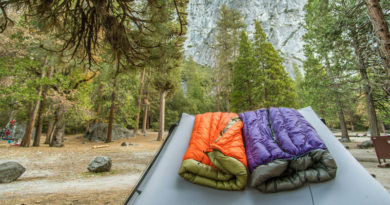Best Budget Ultralight Tents of 2024
Want to hit the trail without your pack feeling like it weighs a ton? Ultralight tents are your friend! But with all the fancy materials and features out there, they can get pricey fast. This guide is here to help you find the best ultralight tent for your wallet. We’ll break down the top options that are both lightweight and budget-friendly, so you can spend less on gear and more on enjoying the outdoors. From trekking pole shelters to classic double-wall tents, we’ve got you covered for your next adventure.
1. NEMO Hornet OSMO
Packaged Weight: 1 lb. 13 oz.
Packed Size: 7.5 x 12.5 in.
Floor Area: 22.3 sq. ft.
Peak Height: 39 in.
Capacity: 1-Person
The NEMO Hornet OSMO is a great choice for backpackers who want a lightweight tent with plenty of space. It weighs just around 2 pounds and packs down small, but it has a large door and vestibule for storing your gear. The tent is also made with high-performance fabric that is water-repellent and doesn’t stretch much when wet. This means you’ll stay dry and comfortable even in bad weather. It’s also made from recycled materials and doesn’t contain any harmful chemicals.
However, there are a few things to keep in mind before you buy this tent. The fabric can sag when it gets wet, and you may need to adjust the stakes to keep it taut. The zipper can also snag easily, and the rainfly only has velcro at the ends to hold it in place. This means you need to be careful when staking out the tent to avoid pulling it too much on one side. Finally, some testers have reported waking up with water inside the tent after it rained. If you’re looking for a bombproof tent for all conditions, this might not be the best option. But if you’re a gram-counting backpacker who prioritizes weight and space, the NEMO Hornet OSMO is a great choice.
What I like: Weighs only 1 pound 13 ounces, perfect for backpackers prioritizing weight.
What I don’t: OSMO fabric is lighter but may sag when wet and require stake adjustments.
View at Backcountry View at REI View at Amazon
2. Big Agnes Tiger Wall UL
Packaged Weight: 2 lbs. 8 oz.
Packed Size: 5.5 x 18 in.
Floor Area: 28 sq. ft.
Peak Height: 39 in.
Capacity: 2-Person
The Big Agnes Tiger Wall UL is a 2-person tent that uses a single, strong pole for easy pitching and takedown, even in bad weather. Two doors and vestibules mean you can get in and out easily without bringing the outdoors inside. Plus, clever pockets and a hanging bin keep your belongings tidy. This tent is built for backpackers who prioritize weight and functionality. It’s made with high-quality, lightweight materials that resist fading and hold up well on the trail. The rainfly keeps you dry, and the tent body is built to last. Even better, it can be pitched with the rainfly first to keep the inside dry during setup in wet conditions.
However, a couple of things to consider. While the zippers seem durable so far, their small size and location can be a bit inconvenient, especially from inside the tent. Also, this tent isn’t the best for super wet weather. With proper pitching, you can stay dry most of the time, but it might not be the most forgiving option in heavy downpours. Overall, the Tiger Wall UL is a great choice for backpackers who are looking for a lightweight, feature-rich tent. It’s not perfect – the zippers can be a bit finicky, and it might not be the best choice for super wet conditions – but for most backpackers, this tent is a great way to elevate your backcountry camping experience.
What I like: Great for backpackers who prioritize weight savings.
What I don’t: Door zippers meet awkwardly and the rainfly zipper is small and potentially prone to wear.
View at Backcountry View at REI View at Amazon
3. NEMO Hornet OSMO 2
Packaged Weight: 2 lbs. 1 oz.
Packed Size: 7.5 x 12.5 in.
Floor Area: 27.5 sq. ft.
Peak Height: 39 in.
Capacity: 2-Person
Backpackers looking for a cheap ultralight tent with more elbow room will be impressed by the NEMO Hornet OSMO. This 2-person tent weighs just over 2 pounds, but thanks to its clever design, it offers surprising comfort and space. The tent uses a new, super-repellent fabric called OSMO that sheds water 4 times better than previous Hornet models and holds its shape even when wet. It’s also made from 100% recycled materials and avoids harmful chemicals.
Setting up the tent is easy, and the unique pole design creates extra space at your head. Large doors and vestibules mean you’ll have plenty of room for your gear, and thoughtful features like glow-in-the-dark clips and a special pocket for your headlamp add to the convenience. However, some users have reported issues with the sealant inside the tent peeling after just one use. This could be a quality control issue, and while it doesn’t seem to affect the tent’s performance, it’s a concern for the price point. If you’re looking for a spacious and eco-friendly ultralight tent, the NEMO Hornet OSMO is a great option, but be sure to inspect the seams carefully before heading out on your adventure.
What I like: Packs down small in the included Divvy Cube stuff sack, fitting easily in your backpack.
What I don’t: Some testers have reported the sealant on the inside of the tent wearing off quickly. This could be a quality control issue and may not affect all tents.
View at Backcountry View at REI View at Amazon
4. Naturehike Cloud-Up

Packaged Weight: 3 lbs. 5.6 oz.
Packed Size: 5.1 x 16 in.
Floor Area: 24.8 sq. ft.
Peak Height: 39.7 in.
Capacity: 1-Person
The Naturehike Cloud-Up is a budget lightweight backpacking tent that is built to withstand the elements. The rainfly is made with waterproof PU4000mm material and taped seams to keep you dry, while the sturdy 7001 aluminum alloy frame holds up strong in wind and rain. Don’t worry about feeling cramped – the Cloud Up 1 offers surprisingly spacious living quarters for one person, with enough headroom to sit up comfortably. There’s even a vestibule at the front for storing your gear or cooking during bad weather. Another perk? This tent comes with everything you need to get started, including a footprint, pegs, guylines, poles, a rainfly, an inner tent, and even a carrying bag.
Setting up the Cloud Up 1 is a breeze. With just one set of aluminum poles, even beginners can assemble it in under two minutes. This double-layer tent offers excellent ventilation thanks to the high-density B3 mesh inner tent. The tent also comes with a footprint, so you don’t need to buy one separately. With plenty of space for one person to sleep comfortably and a vestibule for storing gear or cooking during bad weather, the Cloud Up 1 offers everything you need for a successful solo camping trip. While it can technically fit two slim people, it’s best suited for single adventurers who prioritize affordability, weight, and ease of use.
What I like: This affordable tent offers enough space for one person to sleep comfortably with good headroom and a vestibule for storing gear or cooking during bad weather.
What I don’t: Compared to some high-end backpacking tents, the Cloud Up 1 might be slightly heavier.
5. Big Agnes Copper Spur HV UL1
Packaged Weight: 2 lbs. 6 oz.
Packed Size: 5.5 x 17.5 in.
Floor Area: 20 sq. ft.
Peak Height: 38 in.
Capacity: 1-Person
This tent offers several thoughtful features for backpackers. The 3D bin at the foot of the tent provides off-the-floor storage for your dirty shoes or wet gear. The oversized ceiling pocket allows you to stash a headlamp or other essentials you might need at night. There are also media pockets for routing headphone cords. The tent uses a unique TipLok Tent Buckle system that combines three functions: securing the pole tips, attaching the rainfly, and tensioning the tent. This not only simplifies setup but also helps stabilize the structure. The double ripstop nylon material is lightweight yet strong, offering good tear and puncture resistance.
However, this tent might not be for everyone. While it offers easy setup and plenty of space for one person, there are some design quirks that could be bothersome. The double zipper door requires unzipping two sides to tie one side open, which some might find inconvenient. The door is also positioned at one end of the tent, making it difficult to switch the head end if the ground is uneven. Additionally, the large overhead pocket can cause the tent to feel claustrophobic if you store anything heavy in it. Finally, the center pole can be tricky to assemble, especially when the tent is new and dry.
What I like: Dual low-vent vestibule doors and a high-fly vent maximize airflow and minimize condensation.
What I don’t: The door’s fixed position may be an issue on uneven terrain.
View at Backcountry View at REI View at Amazon
6. Big Agnes Fly Creek HV UL1
Packaged Weight: 2 lbs.
Packed Size: 5 x 18.5 in.
Floor Area: 20 sq. ft.
Peak Height: 40 in.
Capacity: 1-Person
This Fly Creek is a one-person tent, but a redesigned version that offers more space than previous models. This means you’ll have more headroom and a bigger entryway. The special pole design creates steeper walls, so you’ll have more usable space without adding extra weight. This tent is built to be lightweight and easy to set up. It comes with all the features you need for a comfortable backpacking trip, like a mesh door for ventilation, pockets for storing your gear, and reflective guy lines for night visibility. The fabric is also solution-dyed, which means it resists fading from the sun. Overall, the Big Agnes Fly Creek HV UL1 is a great option for backpackers who want a tent that’s light, comfortable, and easy to use.
Setting up the Fly Creek HV UL1 is easy, with a single-pole hub design that creates a stable structure. The tent uses high-quality materials, including solution-dyed fabric that resists fading from the sun. All the seams are taped with waterproof material to keep you dry in wet weather. Another perk is that the tent packs up small, so it won’t take up much space in your backpack. However, it’s important to consider that lightweight materials can also be more delicate. Our tester found the fabric near the zipper starting to separate after just a few uses. It’s always a good idea to be gentle with your gear, especially ultralight options.
What I like: The single-pole hub design and pre-attached guylines make pitching the tent quick and hassle-free.
What I don’t: The vestibule area might be cramped for storing large backpacks or gear.
View at Backcountry View at REI View at Amazon
7. Mountain Hardwear Nimbus UL1
Packaged Weight: 1 lb. 14.6 oz.
Packed Size: 5 x 12 in.
Floor Area: 19.7 sq. ft.
Peak Height: 38 in.
Capacity: 1-Person
The Mountain Hardwear Nimbus UL tent is designed to keep your pack light without sacrificing protection from the elements. It’s a great choice for solo backpackers who value a balance between weight and functionality. The tent is made with a super lightweight, waterproof sil-nylon fly. This special material is strong and durable, but it won’t weigh you down. It’s also eco-friendly because the dye-free manufacturing process reduces water and chemical use. Setting up the tent is a breeze thanks to the pre-connected poles and clever G-hook attachment system. There’s even a handy vestibule area to store your gear, keeping it dry and out of the way.
While the Nimbus UL excels as a solo shelter, backpackers should be aware of its limitations. Tight quarters make squeezing two people uncomfortable, especially with gear stored in the vestibule. The lightweight design trades some sturdiness for packability, meaning strong winds can cause the single center pole to flex and reduce interior space. Additionally, the light-colored fly shows dirt easily, so those prioritizing pristine gear might need to be more vigilant about cleaning. However, for typical backpacking conditions, the Nimbus UL 1 offers exceptional value. Its featherweight build keeps your pack nimble, the pre-connected poles and G-hook system ensure speedy setup, and the sil-nylon fly provides reliable protection from rain, bugs, and the elements.
What I like: The sil-nylon fly and overall design make this tent a great choice for weight-conscious backpackers.
What I don’t: The light-colored fly can easily show dirt, requiring more cleaning for those who prefer pristine gear.
See the Nimbus UL1 See the Nimbus UL2
8. MSR Hubba Hubba 1
Packaged Weight: 2 lbs. 7 oz.
Packed Size: 4 x 19 in.
Floor Area: 18 sq. ft.
Peak Height: 37 in.
Capacity: 1-Person
This three-season tent is built for comfort and functionality. It’s roomy enough to fit all your gear inside, thanks to its true rectangular floor that doesn’t taper at the foot end. The true rectangular floor means no squeezing in, and the 37 inches of headroom lets you sit up without feeling cramped. The tent’s clever design combines mesh panels for ventilation with solid fabric for privacy and protection from the elements. Plus, the rainfly has a big vestibule to store your muddy boots and backpack, keeping the inside clean and dry. There are even handy pockets for your headlamp and other small essentials you need close at hand.
This tent is built tough too. The Easton Syclone poles can handle strong winds, and the waterproof coating and taped seams will keep you dry in heavy rain. The tester loved the tall interior space but did mention some leaking issues from the rainfly in their experience. Setting up the Hubba Hubba 1 is a breeze. The tent features a unified hub-and-pole system and a symmetrical design, making it easy to pitch even when the weather turns nasty. Plus, the rainfly has a large vestibule where you can store your muddy hiking boots or backpack. The vestibule even has a special vent to keep fresh air circulating and a gutter to direct rainwater away from you and your gear.
What I like: Enjoy the night sky through the mesh ceiling in clear weather.
What I don’t: Setting up the inner tent before the rainfly isn’t convenient in wet conditions.
See the Hubba Hubba 1 See the Hubba Hubba 2 See the Hubba Hubba 3
9. REI Co-op Flash Air 2
Packaged Weight: 2 lbs. 13.65 oz.
Packed Size: 6.9 x 17.9 in.
Floor Area: 28.72 sq. ft.
Peak Height: 46.85 in.
Capacity: 2-Person
Looking for the lightest yet cheapest 2-person tent to shed precious ounces on your next backpacking trip? The REI Co-op Flash Air 2 might be your pick. It’s incredibly lightweight, thanks to its slim design and the option to use your trekking poles instead of the included ones. You can even ditch the included poles and use your trekking poles instead to shave off even more weight. Despite its featherlight design, the Flash Air 2 offers surprising comfort for two people. The near-vertical walls and specially designed poles create a roomy interior with plenty of head and toe space. The tent also features two large doors for easy entry and exit, and handy mesh pockets to keep your gear organized.
However, it’s important to note that this tent is not freestanding. Setting it up requires staking it out properly, and this can be a bit tricky, especially for solo campers. The tension on the cords is crucial, and if not done right, the tent can collapse. If you’re looking for a hassle-free setup and plan on camping in various locations, this might not be the best choice. But for experienced backpackers who prioritize weight and are comfortable with staking out their tent, the Flash Air 2 offers a great combination of lightness and livability.
What I like: Despite being ultralight, the tent offers decent space inside with near-vertical walls and a foot pole design for extra wiggle room.
What I don’t: Getting the tension on the cords just right is crucial and can be frustrating, especially for beginners.
10. Sea to Summit Alto TR 1
Packaged Weight: 2 lbs. 7.2 oz.
Packed Size: 4.3 x 17.7 in.
Floor Area: 19.5 sq. ft.
Peak Height: 42.5 in.
Capacity: 1-Person
This ultralight tent weighs a mere 2 pounds 1 ounce (minimum trail weight). Yet, it offers surprising roominess thanks to its unique Tension Ridge design. This innovative feature creates near-vertical walls, maximizing the usable floor space and providing ample headroom for sitting up and changing clothes. Ventilation is also a strong point of the Alto TR1. The high Apex Vent efficiently removes warm air and prevents condensation, while adjustable lower vents allow you to manage humidity in various weather conditions. Plus, the rainfly can be rolled up for stargazing on clear nights and quickly deployed when rain threatens. With its thoughtful design and lightweight construction, the Alto TR1 strikes a great balance between livability and portability for solo backpackers.
However, it’s important to consider the limitations of a one-person tent. The interior space is best suited for a single person and their gear. While the high doorway allows for easy entry and exit, there’s not much wiggle room for two people or bulky equipment. Additionally, the lightweight of the tent might translate to a less sturdy feel compared to heavier models. If you prioritize absolute comfort over minimal weight, you might be better off considering a different option.
What I like: Apex Vent and adjustable lower vents manage humidity and condensation effectively.
What I don’t: Lightweight construction might feel less sturdy than heavier tents.
See the Alto TR1 See the Alto TR2
Best Budget Ultralight Tents: Summary
| TENT | WEIGHT | PACKED SIZE | AREA | HEIGHT | CAPACITY |
|---|---|---|---|---|---|
| NEMO Hornet OSMO | 1 lb. 13 oz. | 7.5 x 12.5 in. | 22.3 sq. ft. | 39 in. | 1-Person |
| BA Tiger Wall UL | 2 lbs. 8 oz. | 5.5 x 18 in. | 28 sq. ft. | 39 in. | 2-Person |
| NEMO Hornet OSMO 2 | 2 lbs. 1 oz. | 7.5 x 12.5 in. | 27.5 sq. ft. | 39 in. | 2-Person |
| Naturehike Cloud-Up | 3 lbs. 5.6 oz. | 5.1 x 16 in. | 24.8 sq. ft. | 39.7 in. | 1-Person |
| BA Copper Spur | 2 lbs. 6 oz. | 5.5 x 17.5 in. | 20 sq. ft. | 38 in. | 1-Person |
| BA Fly Creek | 2 lbs. | 5 x 18.5 in. | 20 sq. ft. | 40 in. | 1-Person |
| MH Nimbus UL1 | 1 lb. 14.6 oz. | 5 x 12 in. | 19.7 sq. ft. | 38 in. | 1-Person |
| MSR Hubba Hubba 1 | 2 lbs. 7 oz. | 4 x 19 in. | 18 sq. ft. | 37 in. | 1-Person |
| REI Co-op Flash Air 2 | 2 lbs. 13.65 oz. | 6.9 x 17.9 in. | 28.72 sq. ft. | 46.85 in. | 2-Person |
| Sea to Summit Alto TR 1 | 2 lbs. 7.2 oz. | 4.3 x 17.7 in. | 19.5 sq. ft. | 42.5 in. | 1-Person |
How to Choose a Tent for Ultralight Adventures?
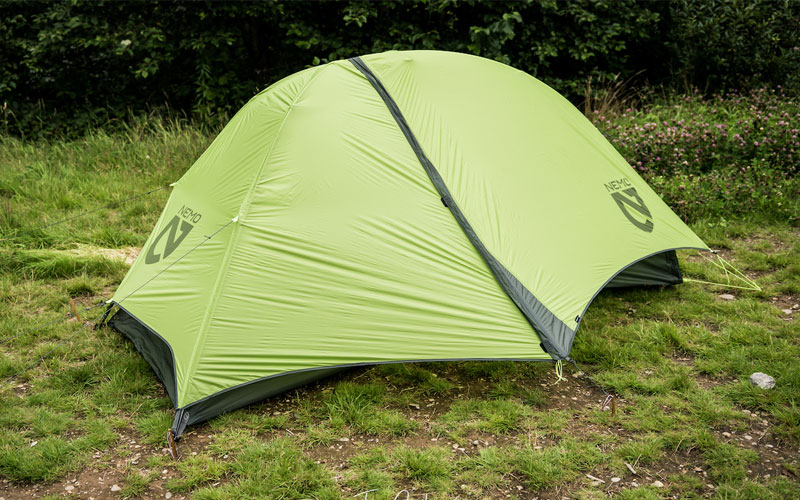
For backpackers, every ounce counts. The lighter your pack, the happier your shoulders and knees will be on those long hikes into the wilderness. Ultralight backpacking takes this philosophy to the extreme, focusing on minimizing weight in every aspect of your gear, especially your shelter. But with a lighter tent comes the potential for sacrificing comfort and protection. This guide will help you navigate the world of ultralight backpacking tents, ensuring you find the perfect balance between weight, livability, and weather protection for your adventures.
Understanding Your Needs
Before diving into specific tent features, take a step back and consider your backpacking style and needs. Here are some key questions to ask yourself:
- Solo or Group Hiking? Ultralight tents come in one-person and two-person configurations. Two-person tents can be lighter per person if shared, but solo shelters offer ultimate portability.
- What Season Will You Backpack? Three-season tents are the most common ultralight option, designed for spring, summer, and fall. For winter adventures, you’ll need a stronger, four-season tent that can handle snow and high winds.
- How Important is Livability? Ultralight tents often prioritize weight over space. Decide how much space you need for sleeping, gear storage, and sitting up comfortably.
- Budget Considerations Ultralight tents tend to be more expensive due to specialized materials and construction techniques. Determine your budget and prioritize features that matter most to you.
Key Considerations for Ultralight Backpacking Tents
Now that you understand your needs, let’s delve into the specific features that differentiate ultralight tents:
- Weight: This is the holy grail of ultralight backpacking. Aim for a tent body weight (excluding poles and stakes) under 2 pounds for one-person shelters and under 3 pounds for two-person tents.
- Packed Size: A tent that packs down small is essential for efficient backpack organization. Look for tents that compress to fit easily into a side pocket of your pack.
- Minimum Footprint: Ultralight tents often have a smaller footprint to minimize weight. Consider your sleeping style and the likelihood of sharing the tent with another person.
- Materials: Ultralight tents use lightweight, high-tech fabrics like sil-nylon or Dyneema Composite Fabrics (DCF) for the tent body. These materials are excellent for weight savings but may be less durable or waterproof than traditional backpacking tents.
Balancing Weight with Other Factors
While weight is crucial, don’t neglect other vital aspects of your shelter:
- Weather Protection: Ultralight tents prioritize weight over bombproof construction. Three-season tents are generally good for light rain and wind, but consider seam sealing and rainfly coverage for added protection, especially in wet climates. Four-season tents offer more robust weatherproofing for winter adventures.
- Ventilation: Good ventilation is essential to prevent condensation buildup and maintain comfort. Look for tents with ample mesh panels in the walls and ceiling to promote airflow.
- Livability: Don’t underestimate the importance of a comfortable sleeping space. Consider the tent’s interior height, length, and features like vestibules for gear storage. Try setting up the tent before you buy it, if possible, to get a feel for the interior space.
- Ease of Setup: After a long day of hiking, a simple and quick setup is a lifesaver. Look for tents with user-friendly pole structures and intuitive pitching mechanisms.
Additional Considerations
- Freestanding vs. Non-Freestanding: Freestanding tents can be pitched anywhere, while non-freestanding tents require trekking poles or stakes for support. Trekking pole tents can be lighter but limit your pole use during the day.
- Double Wall vs. Single Wall: Double-wall tents have a separate rainfly to create a breathable space. Single-wall tents are lighter but can suffer from condensation issues. Three-season ultralight tents are typically double-wall.
- Tent Poles: Ultralight tents often use lightweight, collapsible poles made from carbon fiber or aluminum. Consider the weight and durability of the pole options available.
- Stakes: Ultralight tents may come with specialized lightweight stakes. Upgrading to stronger stakes can be a good idea for better performance in windy conditions.
Ultralight Tent Options and Trade-offs
Having a solid grasp of the key considerations, let’s explore different ultralight tent options and the trade-offs involved:
- Double-Wall vs. Single-Wall Shelters:
- Double-wall tents, the most common type, offer superior breathability by separating the rainfly from the inner tent body with mesh walls. This prevents condensation buildup on your sleeping bag and keeps you comfortable. However, they are heavier than single-wall tents.
- Single-wall tents, made from a waterproof and breathable fabric, are lighter due to the absence of a separate rainfly. But, condensation management can be an issue, especially in humid environments. Single-wall tents are best suited for experienced backpackers comfortable managing condensation and prioritizing weight savings.
- Freestanding vs. Trekking Pole Tents:
- Freestanding tents offer ultimate pitching flexibility as they can be set up anywhere without additional support. This comes at the cost of slightly more weight due to the additional poles needed for freestanding design.
- Trekking pole tents utilize your existing trekking poles for support, saving weight on dedicated tent poles. However, you’ll be reliant on having your trekking poles available for pitching the tent. This option might not be ideal for situations where you occasionally use your poles for other purposes while the tent is pitched.
- Minimalist Shelters:
- For the ultimate weight-saving backpackers, minimalist shelters like tarps and bivy sacks offer the bare minimum protection from the elements. Tarps provide basic coverage from rain and wind but offer no bug protection or privacy. Bivy sacks are essentially lightweight waterproof shells that enclose your sleeping bag, offering basic protection from wind and rain but limited space and claustrophobic for some. These options require a high level of experience and comfort with exposed camping.
Making the Final Choice
With a good understanding of your needs and the various ultralight tent options, you’re ready to make your final decision. Here are some additional tips:
- Prioritize features based on your needs. If you backpack in wet climates, prioritize weather protection over ultralight weight. If weight is your top concern, consider sacrificing some livability features.
- Research specific tent models. Once you have a general idea of the type of tent you need, delve into specific models, comparing weight, features, and user reviews.
- Consider used gear. Ultralight tents can be expensive. Look for used gear in good condition to save money.
- Practice pitching your tent. Before heading out on your backpacking trip, practice setting up your new tent at home. This will ensure a smooth setup process when you’re out in the wilderness.
Conclusion
In conclusion, ultralight backpacking is a journey of finding the perfect balance between weight, comfort, and protection for your individual needs. By prioritizing your needs, researching different options, and understanding the trade-offs involved, you can choose the ultralight tent that will elevate your backpacking experience.

